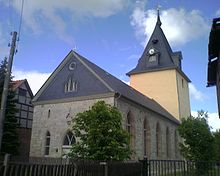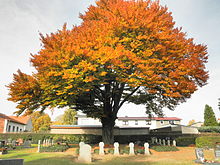Schernberg (Sondershausen)
|
Schernberg
District town Sondershausen
Coordinates: 51 ° 19 ′ 39 ″ N , 10 ° 46 ′ 8 ″ E
|
|
|---|---|
| Height : | 330 m above sea level NN |
| Residents : | 910 (Oct 2009) |
| Incorporation : | December 1, 2007 |
| Postal code : | 99706 |
| Area code : | 036020 |
|
Location of the district of Schernberg
in the city of Sondershausen |
|
Schernberg is a district of the district town of Sondershausen in the Thuringian Kyffhäuserkreis .
geography
Schernberg is located on the southern edge of the wooded Hainleite .
history
The first documentary mention of Schernberg comes from the year 772, the document is kept in Marburg . In 1203 the knights of Schernberg are mentioned in a document. In 1525 Dietrich von Tettenborn, the son of the knight Bernhard von Tettenborn, was slain on his Schernberg estate. The St. Crucis Church was built in 1565. Just a few years later, the plague raged in the village and claimed around 80 victims in 1582 and another 88 in 1597. From 1603 to 1607 the cantor Petersdorf from Sondershausen taught Latin to the students in Schernberg. This gave Schernberg the name "University Town".
On June 1, 1805, King Friedrich Wilhelm III. of Prussia with his wife, Queen Luise, on the journey from Nordhausen to Erfurt, welcomed and entertained by Prince Günther Friedrich Karl I and his court at the Schernberger Lehde. To commemorate this meeting there is a copper beech on the "Königsplatz". Schernberg has had a judicial office since 1834 and a telegraph office was opened in the post office in 1880. Until 1918 the place belonged to the rule of the principality Schwarzburg-Sondershausen . In 1924 the city's first street lighting was put into operation. During the Second World War , Gut Schernberg was declared a front-line operation in 1945.
On April 10, 1945, US troops attacked a German defensive position at the "Graßecke" chausseehaus on the road towards Sondershausen. When it came to the loss of a US tank, air support was requested. Fighter-bombers then attacked not only the Graßecke and German positions north of Hohenebra , but also Schernberg itself. 6 civilians were killed in the village and 22 buildings caught fire. When a Jabo was shot down at the Graßecke, the Americans also used heavy artillery. 17 German soldiers of the Wehrmacht were killed, 14 of them were young people born between 1926 and 1928. They were non-commissioned officers' students and members of the Luftwaffe music corps in Sondershausen. It was not until April 16 that they were solemnly buried in a mass grave at the site of the event, with great sympathy from the residents. The bones were then transferred to the Schernberg cemetery in 1949. The graves under a large copper beech were well cared for during the Soviet occupation zone and the GDR and provided with wooden crosses. After the fall of the Berlin Wall, the Volksbund Deutsche Kriegsgräberfürsorge set stone crosses for everyone who fell. A family of three committed suicide in Schernberg prior to the occupation by US troops.
The American occupation was replaced by the Red Army in early July 1945 . Schernberg became part of the SBZ and, from 1949, the GDR . One consequence was the collectivization of the farms from 1952 onwards. The former manor house was partially destroyed on the orders of the Soviet occupying forces.
Scherenburg
In Schernberg, the castle Scherenburg presumed to be on the Hainleite could have stood, so the possibility is represented. But it is also seen as desolate on the Hainleite. The Scherenburg, which is said to have been on the Hainleite, is regarded as the original ancestral seat of the von Schlotheim family , who inherited the office of truchess of the Landgraviate of Thuringia , because it included the scissors in the coat of arms. According to this, the later Lords of Schlotheim and Truchsesse of the Landgraviate of Thuringia left the Scherenburg before 1174 and took their seat in Schlotheim . In 1267, not far from Schernberg, with seat at Straussberg Castle , in today's district of Sondershausen Straussberg , the landgrave's truchess of Thuringia Berthold von Schlotheim documents . It is considered possible that the Scherenburg could have stood on the site of today's Schernberg churchyard. The castle-like church tower today could have been part of the earlier Scherenburg.
The former community of Schernberg
In 1993 the communities of Schernberg, Immenrode , Hohenebra , Thalebra , Kleinberndten , Großberndten and Straussberg merged to form an administrative community. On January 1, 1996, the places were incorporated into Schernberg. On October 12, 2006, a contract was signed that included the integration of the Schernberg community into the district town of Sondershausen and came into force on December 1, 2007.
Population development
Development of the population (December 31) :
|
- Data source: Thuringian State Office for Statistics
traffic
The Schernberg stop was on the Hohenebra – Ebeleben railway line . Only freight trains run here .
Web links
Individual evidence
- ↑ Jürgen Möller: The fight for northern Thuringia in April 1945 . Rockstuhl Verlag, Bad Langensalza 2010. pp. 85-93. ISBN 978-3-86777-212-9 .
- ↑ so Thuringian castles and fortified prehistoric and prehistoric living spaces, Michael Köhler, 3rd edition, 2010, pp. 281, 282.
- ↑ a b c Hans Patze (Ed.): Handbook of the historical sites of Germany . Volume 9: Thuringia (= Kröner's pocket edition . Volume 313). 2nd, improved and supplemented edition. Kröner, Stuttgart 1989, ISBN 3-520-31302-2 , pp. 385-386.
- ↑ Hans Patze (Ed.): Handbook of the historical sites of Germany. Volume 9: Thuringia (= Kröner's pocket edition. Volume 313). 2nd, improved and supplemented edition. Kröner, Stuttgart 1989, ISBN 3-520-31302-2 , p. 425.
- ^ So Thuringian castles and fortified prehistoric and prehistoric residential areas, Michael Köhler, 3rd edition, 2010, pp. 281, 282.
- ^ Thuringian castles and fortified prehistoric and prehistoric living spaces, Michael Köhler, 3rd edition, 2010, pp. 281, 282.
- ^ StBA: Changes in the municipalities in Germany, see 1996
- ^ StBA: Changes in the municipalities in Germany, see 2007



